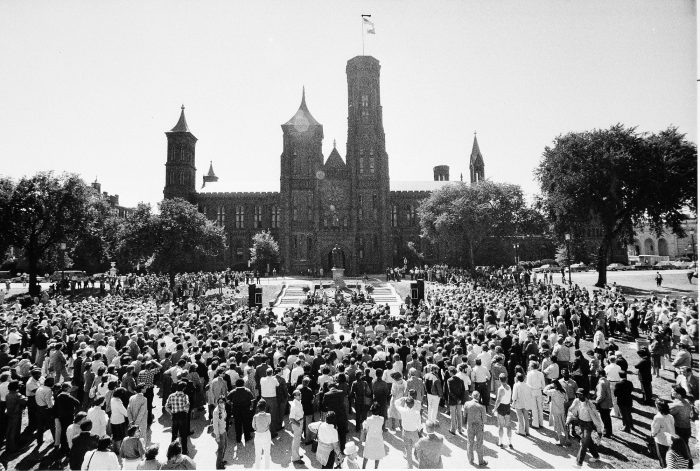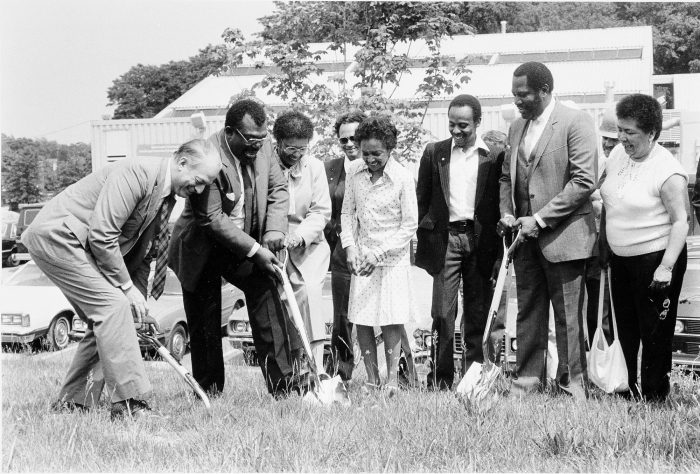In Memoriam: Robert McCormick Adams
Robert McCormick Adams
July 23, 1926 – Jan. 27, 2018
The ninth Secretary of the Smithsonian Institution, Robert McCormick Adams, died Saturday, Jan. 27, in Chula Vista, Ca. He was 91.

Smithsonian staff, volunteers and visitors on The Mall in front of the Smithsonian Institution Building to watch the installation ceremony of Secretary Adams, September 17, 1984. (Photo by Jeff Tinsley)
A distinguished anthropologist, Adams was installed as the Secretary of the Smithsonian Sept. 17, 1984, succeeding S. Dillon Ripley. He retired in 1994.
During his tenure at the Smithsonian, Adams focused on expanding scientific research, especially in the field of biological diversity; improving the Institution’s educational and public programs; and strengthening outreach efforts that bring the Smithsonian to people across the country and around the world.

Ninth Smithsonian Secretary (1984-1994) Robert McCormick Adams (1926- ), signs Memorandum of Understanding with Museum of American Indian (MAI), Heye Foundation, transferring its superb collection of American Indian artifacts to Smithsonian at ceremony on May 8, 1989, overlooking the site of the hoped-for new National Museum of the American Indian to be built on the Mall in Washington to house Heye Foundation Collection. Looking on left to right: Suzan Harjo, member of board of trustees, Museum of the American Indian, Heye Foundation, New York City; Roland Force, director MAI; Senator Daniel K. Inouye (D-HI), chief support of legislation to create NMAI within SI; Dick Baker, member Lakota Sioux Red Feather Society; Congressman Ben Nighthorse Campbell (D-CO), only American Indian member in Congress. (Photo by Laurie Minor-Penland)
Adams considered the establishment of the Smithsonian’s National Museum of the American Indian to be his most significant accomplishment. He began negotiations with the Museum of the American Indian, Heye Foundation, in New York City just months after he arrived at the Smithsonian. The Heye Foundation housed the world’s most comprehensive Native American collection but was experiencing financial difficulties. In 1989, President George H.W. Bush signed legislation that transferred the collection to the Smithsonian to establish a National Museum of the American Indian on the National Mall near the U.S. Capitol (opened 2004), as well as a permanent exhibition facility in New York City (opened 1994) and a collections and research center in Suitland, Md.

Ceremonial groundbreaking at 1901 Fort Place, S.E., Washington, D.C., in May 1985, for the Anacostia Neighborhood Museum (AM), renamed the Anacostia Museum in 1987. In 1995 the Museum was renamed Anacostia Museum and Center for African American History and Culture. After the Smithsonian launched its new National Museum of African American History and Culture, the Museum was renamed Anacostia Community Museum in 2006. Left to right: Museum Historian Louise Hutchinson (AM), Robert Stanton (National Park Service), John Blake (chair of AM board), Ann King (former president of Fort Stanton Citizens Association[FSCA]), James Mayo (ANM exhibit supervisor), Addie Cook (FSCA president), AM Director John Kinard and Secretary Robert McCormick Adams. The museum opened in the Carver Theater building in 1967. (Photo by Rhawn Anderson)
During Adams’ time as Secretary, several other museums joined the Smithsonian. The National Postal Museum, located in Washington, D.C.’s City Post Office Building on Capitol Hill, became the country’s first museum devoted exclusively to stamps and postal history when it opened in July 1993. Six years earlier, the National Museum of African Art and the Arthur M. Sackler Gallery opened, as well as the S. Dillon Ripley Center, home to the Smithsonian Institution Traveling Exhibition Service, the International Center and Smithsonian Associates.

In 1984, ninth Secretary Robert McCormick Adams, wearing a construction hat, checks the construction of the underground museum complex that will houses the National Museum of African Art, the Arthur M. Sackler Gallery and S. Dillon Ripley International Center. The complex opened three years later. The Smithsonian Institution Building, or “Castle”, is visible in the background along with cranes and other construction machinery. (Photo by Richard K. Hoffmeister)
Plans for two new museums were also underway at the time of Adams’ retirement from the Smithsonian: the Steven F. Udvar-Hazy Center, an extension of the National Air and Space Museum, located at Dulles Airport in Virginia (opened 2003), and the National Museum of African American History and Culture (opened 2016).
As a well-known anthropologist, Adams always placed a high priority on science projects and research at the Smithsonian. One year after his arrival, he established the National Science Resources Center, a joint project of the Smithsonian and the National Academy of Sciences to improve the teaching of science and math.
Adams was best known for his archeological fieldwork in ancient Mesopotamia (modern-day Iraq), site of one of the world’s earliest civilizations. He conducted 10 seasons of field research in Iraq over a 25-year period. He also did extensive archeological research in Mexico, Iran, Syria and Saudi Arabia. His book Heartland of Cities: Surveys of Ancient Settlement and Land Use on the Central Floodplain of the Euphrates (1981) has become a classic text in the field.
Adams was born in Chicago July 23, 1926, and graduated from the University of Chicago, where he received a bachelor’s degree in 1947, a master’s degree in 1952 and a doctorate in 1956.
Posted: 30 January 2018
- Categories:




